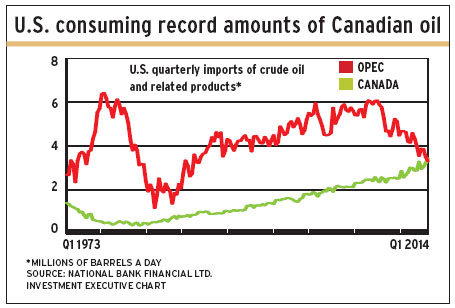
Although U.S. oil production has surged as a result of the discovery of shale oil, that’s not having an impact on Canada’s oil exports. Indeed, U.S. purchases of oil from Canada have continued to rise at a fast clip, according to a report from Stéfane Marion, chief economist and strategist with National Bank of Canada in Montreal.
Total U.S. oil production was 7.9 million barrels a day in the first quarter (Q1) of this year. That’s up by 68% from the low of 4.7 million barrels a day in Q3 2008 but still well below the peak of 10 million barrels a day in Q4 1970.
Nevertheless, Canadian oil exports to the U.S. have risen by 46% in Q1 2014 to a record high of 3.4 million barrels a day.
This is because the U.S. has been dramatically reducing its purchases from the Organization of Petroleum Exporting Countries (OPEC).
In Q1, OPEC provided only 3.3 million barrels of oil a day to the U.S., down from a peak of 6.1 million barrels a day in Q2 2007. In fact, Marion notes in his report that Q1 is the first time that oil purchases by the U.S. from Canada have exceeded those from OPEC.
It makes sense that the U.S. would prefer to buy from politically stable Canada, which is right next door, rather than from the potentially risky and volatile OPEC countries. The Middle East always has the potential for upheaval, as does North Africa – and no one would call Venezuela stable.
Given the U.S.’s continuing need for oil imports and its clear preference to buy from Canada, Marion says, it’s puzzling that the U.S. is dragging its feet on approving the Keystone XL pipeline, which would facilitate the movement of Canadian oil to U.S. refineries and storage/distribution facilities.
Keystone XL would be the final part of Calgary-based TransCanada Corp.’s Keystone pipeline system, linking the Alberta sedimentary basin to refineries and storage/distribution facilities in Nebraska, Illinois, Oklahoma and Texas.
Keystone XL would provide a shortcut from Alberta to refineries in Steele City, Neb. Currently, oil travels east from Alberta to Manitoba, then south to Steele City. Keystone XL would send the oil on a diagonal straight from Hardisty, Alta., to Steele City.
The other benefit of Keystone XL is that it goes through the shale oil-rich Bakken deposits and thus could transport that oil as well.
There have been significant protests by environmentalists against Keystone XL, and U.S. President Barrack Obama has delayed making a decision on the proposal until at least after the mid-term elections on Nov. 4 – maybe later.
© 2014 Investment Executive. All rights reserved.